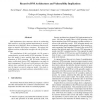Free Online Productivity Tools
i2Speak
i2Symbol
i2OCR
iTex2Img
iWeb2Print
iWeb2Shot
i2Type
iPdf2Split
iPdf2Merge
i2Bopomofo
i2Arabic
i2Style
i2Image
i2PDF
iLatex2Rtf
Sci2ools
NDSS
2009
IEEE
2009
IEEE
Recursive DNS Architectures and Vulnerability Implications
DNS implementers face numerous choices in architecting DNS resolvers, each with profound implications for security. Absent the use of DNSSEC, there are numerous interim techniques to improve DNS forgery resistance. We explore how different resolver architectures can affect the risk of DNS poisoning. The contributions of this work include: (A) We create a comprehensive, accurate model of DNS poisoning. We show how this model is more sensitive than other previous explanations of DNS poisoning. (B) We further catalog the major architectural choices DNS implementers can make in query management. We note real-world instances where these choices have weakened the security of resolvers, and measure the impact on security using our model. Our study revealed numerous, previously unknown vulnerabilities in common DNS servers.
| Added | 21 May 2010 |
| Updated | 21 May 2010 |
| Type | Conference |
| Year | 2009 |
| Where | NDSS |
| Authors | David Dagon, Manos Antonakakis, Kevin Day, Xiapu Luo, Christopher P. Lee, Wenke Lee |
Comments (0)

